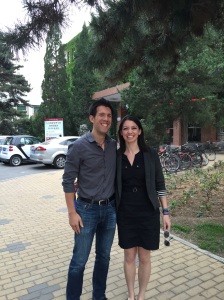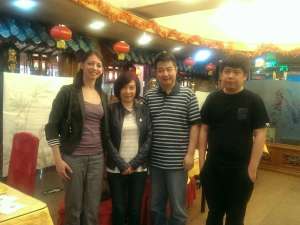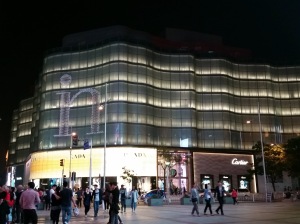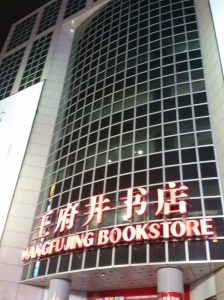May 16, 2015
Social media in China!
Prior to traveling to China, our Chinese Policy course read a book per week about various aspects of Chinese public policy issues. One of the books was on communication policy, The Power of the Internet in China, and it got me really interested in the use of the Internet as a communication and community organizing tool in the Chinese context. In recent years I have developed quite the bond with Twitter, an American social media platform, and I was excited to learn more about the Chinese equivalents. And so, to prepare for the trip–in true millennial stereotypical fashion–I created profiles for some of the most popular platforms to experience the world of Chinese social media.
Popular social media platforms in China:
- Sina WeiBo
- Tudou and Youku
- similar USA platform: YouTube
Facebook, Twitter, and YouTube are similar platforms rather than platform “equivalents” because there are some very notable differences between the Chinese and USA social media platforms in terms of the user experience. For example, while YouTube users might be more prone to post short videos of cute kittens, funny bloopers, and amateur how-to recordings, Tudou and Youku videos tend to be longer and lean more towards professional production rather than D.I.Y. recordings. This difference was notable to me in that it produces a crowd-sourcing user experience that relies more on company-owned profiles to produce the content than it does on individual user profiles.
However, Youku does have a significant amount of user-produced content in the form of video-blogs and daily diaries. That said, Youku continues to support videos discussing feminist issues despite recent arrests of feminist activists. Due to its uncanny resemblance to the Twitter interface, many have referred to Sina Weibo as the Chinese version of Twitter, but my user experience with Weibo was more akin to that of Facebook in terms of the amount and type of content posted (particularly with regards to photos and video), as well as the tailored newsfeed.
The aspect of Weibo very reminiscent of my Twitter experience was the fact that I was interacting almost exclusively with strangers who happened to share the same interests as me. I was interested to learn from a media analysis by Women’s Voice that a disproportionate number of men use Weibo, which made me wonder whether WeChat was the preferred social media platform for women.
WeChat, on the other hand, felt like a fine blend of Twitter and iMessage, in that it served as an effective smartphone instant messaging platform, but it also provided an experience discovery platform that learned from me as time went on during our tour of China. In fact, WeChat’s friend smart recommendations tool was so finely tuned that, in an almost creepy way, I managed to connect with lots of friends upon receiving a WeChat notification that they were within mere kilometers of me at various points in our trip. Given how gigantic China is, this is no small feat.
Friends in China (thanks to WeChat)!
Daniel 谭大林
A major highlight was reuniting with my friend Daniel, whom I had not seen in years. I was thrilled to reconnect with Daniel through WeChat’s “friend recommendations” discovery tool. We had the chance to catch up for a little bit while walking through the beautiful grounds of Renmin University.  After spending several years working rural China, and then pursuing a graduate degree, Daniel is currently a Gruber Fellow in Global Justice and Women’s Rights at the China Foundation for Poverty Alleviation 中和农信, which is a Chinese NGO that does anti-poverty work through micro financing for business development for unbanked people living in China.
After spending several years working rural China, and then pursuing a graduate degree, Daniel is currently a Gruber Fellow in Global Justice and Women’s Rights at the China Foundation for Poverty Alleviation 中和农信, which is a Chinese NGO that does anti-poverty work through micro financing for business development for unbanked people living in China.
I was fascinated to learn about Daniel’s role in helping this NGO to build capacity. The organization essentially uses the Grameen micro finance model, with some small tweaks to adapt to a Chinese context. The program is not dissimilar to Kiva Zip programs in the United States, but the socioeconomic contexts (particularly with regards to rural farming) are wildly different here in China, so the comparison is not a strong one. China Foundation for Poverty Alleviation seems different from many other Micro Credit Companies in China in that it has a social mission and is a not-for-profit. In his robust personal blog, Daniel further discusses micro finance in Chinese rural poverty, and the role that this NGO plays in building relationships with Western European policy makers as they continue to think about supporting bottom-of-the-pyramid citizens.
Jun Jun
While many people in my grandparents’ generation moved to the United States during the World War II Japanese invasion of China, there were still others who did not leave the country.  Jun Jun is one such relative, and I hoped to be able to connect sometime during this trip to China. After several fruitless efforts to connect via email and telephone, we finally found each other on WeChat!
Jun Jun is one such relative, and I hoped to be able to connect sometime during this trip to China. After several fruitless efforts to connect via email and telephone, we finally found each other on WeChat!
I got to meet Jun Jun’s family, and we enjoyed a refreshing walk through a local hutong where neighbors enjoyed dancing in a park lined with roses. We ate dinner at a traditional Muslim Peking Duck House that has been in existence for more than 100 years. We traded stories of how our families have fared in both the United States in China. Afterwards, we used the WeChat photo sharing tool to exchange photos of family members and of our evening together in Beijing.
James
After losing touch for nearly a decade, James and I reconnected in a Beijing subway station through WeChat’s location sharing platform. It was quite the unexpected, albeit welcome, reunion.  We spent the afternoon catching up on old times while sharing a meal in a cluster of Mexican restaurants. The Little Mexico scene in this Beijing hutong provided a reminder of China’s growing relationship with Latin America for the subsequent policy meeting that our Ford School group would have with the Mexican Embassy in Beijing.
We spent the afternoon catching up on old times while sharing a meal in a cluster of Mexican restaurants. The Little Mexico scene in this Beijing hutong provided a reminder of China’s growing relationship with Latin America for the subsequent policy meeting that our Ford School group would have with the Mexican Embassy in Beijing.
James has been living in Beijing for more than six years and is now vice president of BOTO Academic English, a for-profit startup company that prepares students to take the SAT and TOEFL exams in order to apply to undergraduate universities in the United States.  He states that one of the reasons BOTO Academic English out amidst other English education options is that he is fluent in both Mandarin and English, so he is able to engage with both parents and students on a much deeper level than is the typical English tutor who may have limited Mandarin capacity. One of his students successfully took the SAT and TOEFL exams and will be starting her undergraduate studies at University of Michigan in the fall; I am looking forward to connecting with her on WeChat about preparing for her future as a wolverine!
He states that one of the reasons BOTO Academic English out amidst other English education options is that he is fluent in both Mandarin and English, so he is able to engage with both parents and students on a much deeper level than is the typical English tutor who may have limited Mandarin capacity. One of his students successfully took the SAT and TOEFL exams and will be starting her undergraduate studies at University of Michigan in the fall; I am looking forward to connecting with her on WeChat about preparing for her future as a wolverine!
University students
After our formal meetings at Renmin University and Shanghai Jiao Tong University, we had the chance to chat informally with the local students.  Conversations often turned to questions of whether I was on any of the Chinese social media platforms or whether I was “only” on USA-centric platforms like Facebook.
Conversations often turned to questions of whether I was on any of the Chinese social media platforms or whether I was “only” on USA-centric platforms like Facebook.  Students would often remark that they enjoyed following University of Michigan on Weibo 密歇根大学. A few QR Code scans later, and I had developed a new network of Chinese friends! They ranged from undergraduate through graduate school, and studied everything from public administration to chemical engineering to English.
Students would often remark that they enjoyed following University of Michigan on Weibo 密歇根大学. A few QR Code scans later, and I had developed a new network of Chinese friends! They ranged from undergraduate through graduate school, and studied everything from public administration to chemical engineering to English.
Through the informal and quip-filled conversations typical of WeChat, I quickly learned the subculture of sharing animated gifs and floating emoticons as a way to supplement texting, photo sharing, and “moment sharing”. Despite reports of censorship, my limited experience with WeChat made me feel more comfortable keeping in touch with people I had just met, because WeChat allows for some semblance of privacy in that one does not actually have to share contact information with other people in order to stay in touch.
–Kim M, MPP






